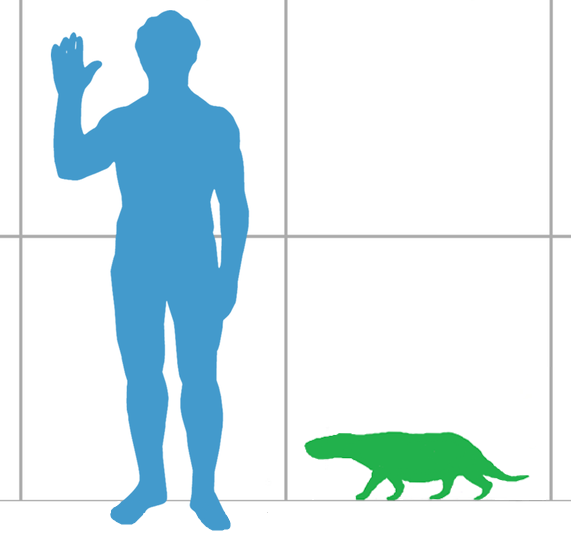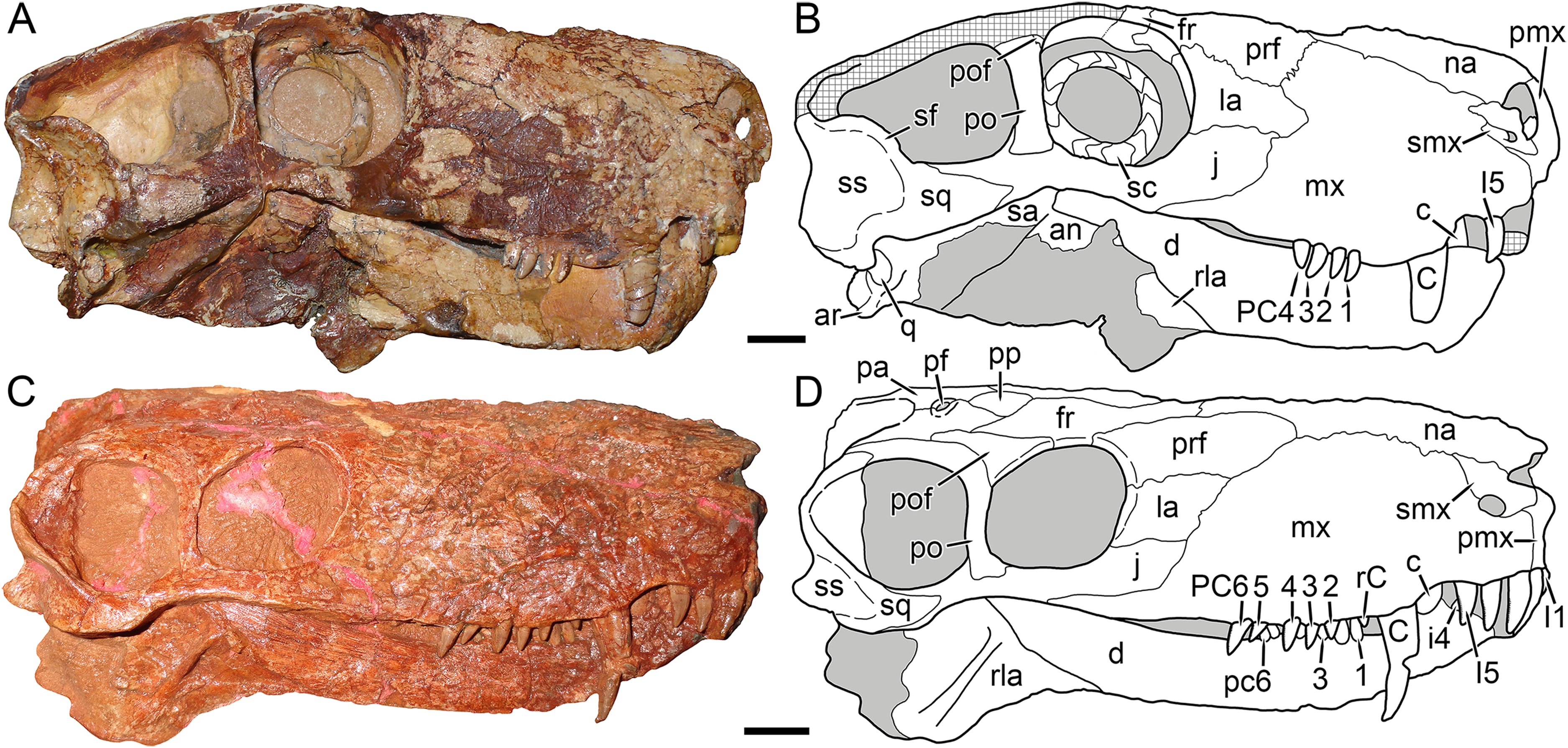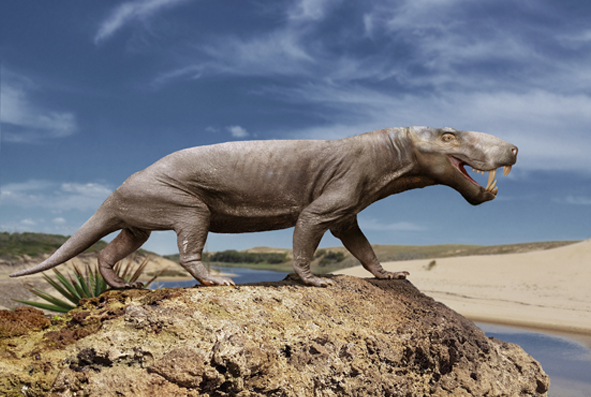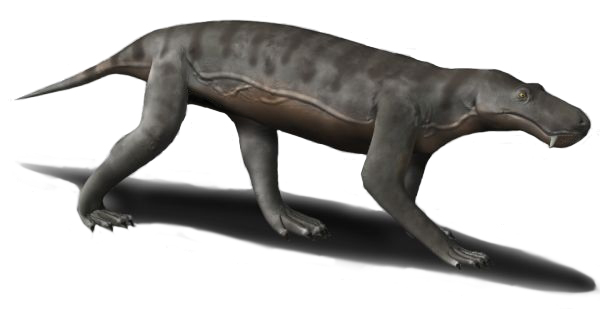|
Nochnitsa
''Nochnitsa'' (rus.: ночница, literally – nightling) is a genus of gorgonopsian therapsid from the Kotelnich red beds of Permian Russia. It contains one species, ''Nochnitsa geminidens''. It the most basal known gorgonopsian and among the smallest members of the clade known to date. Discovery and naming ''Nochnitsa'' is known from only one specimen, the holotype KPM 310. It was found in Vanyushonki Member of the Kotelnich red beds, along the Vyatka River in Kirov Oblast, which dates to the latest Guadalupian or early Lopingian epochs. ''Nochnitsa'' is named after the Nocnitsa, a nocturnal hag-like creature from Slavic mythology. Its name was intended as a parallel to the Gorgons, similarly hag-like creatures from Greek mythology, which are the namesake of many genera within Gorgonopsia and the clade as a whole. The name also reflects the nocturnal habits inferred for the genus. The type species name, ''N. geminidens'', means "twin tooth" and refers to one of the autapo ... [...More Info...] [...Related Items...] OR: [Wikipedia] [Google] [Baidu] |
Viatkogorgon And Nochnitsa Skulls
''Viatkogorgon'' is a genus of gorgonopsian (a type of therapsid, the group that includes modern mammals) that lived during the Permian period in what is now Russia. The first fossil was found at the Kotelnich locality near the Vyatka River and was made the holotype of the new genus and species ''V. ivachnenkoi'' in 1999. The generic name refers to the river and the related genus ''Gorgonops''—the gorgons of Greek mythology are often referenced in the names of the group. The specific name honors the paleontologist Mikhail F. Ivakhnenko. The holotype skeleton is one of the most complete gorgonopsian specimens known and includes rarely preserved elements such as gastralia (abdominal ribs) and a sclerotic ring (a bony ring inside the eye). A larger, but poorly preserved specimen has also been assigned to the species. The holotype specimen is about long, including the long skull, making ''Viatkogorgon'' a relatively small gorgonopsian. The assigned specimen is larger, with a ... [...More Info...] [...Related Items...] OR: [Wikipedia] [Google] [Baidu] |
Viatkogorgon
''Viatkogorgon'' is a genus of gorgonopsian (a type of therapsid, the group that includes modern mammals) that lived during the Permian period in what is now Russia. The first fossil was found at the Kotelnich locality near the Vyatka River and was made the holotype of the new genus and species ''V. ivachnenkoi'' in 1999. The generic name refers to the river and the related genus ''Gorgonops''—the gorgons of Greek mythology are often referenced in the names of the group. The specific name honors the paleontologist Mikhail F. Ivakhnenko. The holotype skeleton is one of the most complete gorgonopsian specimens known and includes rarely preserved elements such as gastralia (abdominal ribs) and a sclerotic ring (a bony ring inside the eye). A larger, but poorly preserved specimen has also been assigned to the species. The holotype specimen is about long, including the long skull, making ''Viatkogorgon'' a relatively small gorgonopsian. The assigned specimen is larger, with a ... [...More Info...] [...Related Items...] OR: [Wikipedia] [Google] [Baidu] |
Nochnitsa Restoration
''Nochnitsa'' (rus.: ночница, literally – nightling) is a genus of gorgonopsian therapsid from the Kotelnich red beds of Permian Russia. It contains one species, ''Nochnitsa geminidens''. It the most basal known gorgonopsian and among the smallest members of the clade known to date. Discovery and naming ''Nochnitsa'' is known from only one specimen, the holotype KPM 310. It was found in Vanyushonki Member of the Kotelnich red beds, along the Vyatka River in Kirov Oblast, which dates to the latest Guadalupian or early Lopingian epochs. ''Nochnitsa'' is named after the Nocnitsa, a nocturnal hag-like creature from Slavic mythology. Its name was intended as a parallel to the Gorgons, similarly hag-like creatures from Greek mythology, which are the namesake of many genera within Gorgonopsia and the clade as a whole. The name also reflects the nocturnal habits inferred for the genus. The type species name, ''N. geminidens'', means "twin tooth" and refers to one of the autapo ... [...More Info...] [...Related Items...] OR: [Wikipedia] [Google] [Baidu] |
Nochnitsa Geminidens Holotype Right Side
''Nochnitsa'' (rus.: ночница, literally – nightling) is a genus of gorgonopsian therapsid from the Kotelnich red beds of Permian Russia. It contains one species, ''Nochnitsa geminidens''. It the most basal known gorgonopsian and among the smallest members of the clade known to date. Discovery and naming ''Nochnitsa'' is known from only one specimen, the holotype KPM 310. It was found in Vanyushonki Member of the Kotelnich red beds, along the Vyatka River in Kirov Oblast, which dates to the latest Guadalupian or early Lopingian epochs. ''Nochnitsa'' is named after the Nocnitsa, a nocturnal hag-like creature from Slavic mythology. Its name was intended as a parallel to the Gorgons, similarly hag-like creatures from Greek mythology, which are the namesake of many genera within Gorgonopsia and the clade as a whole. The name also reflects the nocturnal habits inferred for the genus. The type species name, ''N. geminidens'', means "twin tooth" and refers to one of the autapo ... [...More Info...] [...Related Items...] OR: [Wikipedia] [Google] [Baidu] |
Gorgonopsian
Gorgonopsia (from the Greek Gorgon, a mythological beast, and 'aspect') is an extinct clade of sabre-toothed therapsids from the Middle to Upper Permian roughly 265 to 252 million years ago. They are characterised by a long and narrow skull, as well as elongated upper and sometimes lower canine teeth and incisors which were likely used as slashing and stabbing weapons. Postcanine teeth are generally reduced or absent. For hunting large prey, they possibly used a bite-and-retreat tactic, ambushing and taking a debilitating bite out of the target, and following it at a safe distance before its injuries exhausted it, whereupon the gorgonopsian would grapple the animal and deliver a killing bite. They would have had an exorbitant gape, possibly in excess of 90°, without having to unhinge the jaw. They markedly increased in size as time went on, growing from small skull lengths of in the Middle Permian to bear-like proportions of up to in the Upper Permian. The latest gorgonopsia ... [...More Info...] [...Related Items...] OR: [Wikipedia] [Google] [Baidu] |
Gorgonopsia
Gorgonopsia (from the Greek Gorgon, a mythological beast, and 'aspect') is an extinct clade of sabre-toothed therapsids from the Middle to Upper Permian roughly 265 to 252 million years ago. They are characterised by a long and narrow skull, as well as elongated upper and sometimes lower canine teeth and incisors which were likely used as slashing and stabbing weapons. Postcanine teeth are generally reduced or absent. For hunting large prey, they possibly used a bite-and-retreat tactic, ambushing and taking a debilitating bite out of the target, and following it at a safe distance before its injuries exhausted it, whereupon the gorgonopsian would grapple the animal and deliver a killing bite. They would have had an exorbitant gape, possibly in excess of 90°, without having to unhinge the jaw. They markedly increased in size as time went on, growing from small skull lengths of in the Middle Permian to bear-like proportions of up to in the Upper Permian. The latest gorgonopsia ... [...More Info...] [...Related Items...] OR: [Wikipedia] [Google] [Baidu] |
Inostrancevia
''Inostrancevia'' is an extinct genus of carnivorous therapsids, containing the largest members of gorgonopsians, predators characterized by long, saber-tooth-like canines. The various species inhabited European Russia during the Upper Tatarian (Vyatskian), a Russian regional stage equivalent to the Wuchiapingian and Changhsingian stage of the Late Permian period, dating from approximately 259 to 252.3 million years ago. The genus name was described posthumously, after the Bolshevik Revolution, by the Russian paleontologist Vladimir P. Amalitsky in 1922, in honor of geologist Aleksandr Inostrantsev. The first fossils attributed to ''I. alexandri'' are found in Arkhangelsk Oblast, near the Northern Dvina at the end of the 19th century, making it the first gorgonopsian known from Russia, the only place outside Africa where they are officially recognized. Some fossils of the species in question are among the most complete remains of gorgonopsians ever identified to date, the ... [...More Info...] [...Related Items...] OR: [Wikipedia] [Google] [Baidu] |
Pravoslavlevia
''Pravoslavlevia'' is an extinct genus of gorgonopsian therapsids that lived in the late Permian and is part of the Sokolki subcomplex of Russia. It had a skull long. The total length of the animal was about . Only one species (''P. parva'') is known. Classification The following cladogram showing the position of ''Pravoslavlevia'' within Gorgonopsia follows Kammerer and Masyutin, 2018: See also * List of therapsids This list of therapsids is an attempt to create a comprehensive listing of all genera that have ever been included in the Therapsida excluding mammals and purely vernacular terms. The list includes all commonly accepted genera, but also genera tha ... Sources paleodb.org Gorgonopsia Prehistoric therapsid genera Extinct animals of Russia Fossil taxa described in 1953 {{paleo-therapsid-stub ... [...More Info...] [...Related Items...] OR: [Wikipedia] [Google] [Baidu] |
Eriphostoma
''Eriphostoma'' is an extinct genus of gorgonopsian therapsids known from the Middle Permian (middle Capitanian stage) of ''Tapinocephalus'' Assemblage Zone, South Africa. It has one known species, ''Eriphostoma microdon'', and was first named by Robert Broom in 1911. It is the oldest known gorgonopsian and among the smallest and most basal members of the clade. Description Gorgonopsians were a morphologically conservative group, and like all gorgonopsians, ''Eriphostoma'' would have been a quadrupedal predator. It was among the smaller members of the group, with a skull less than long. It had a relatively short, deep snout and large orbits compared to other gorgonopsians. Like all gorgonopsians, it had five incisors and a canine tooth on each side of the upper jaw, but it had only three small postcanine teeth in its maxilla. The palate of ''Eriphostoma'' has delta-shaped palatine bosses covered in numerous teeth, like ''Gorgonops'' and many basal therapsids, but not more der ... [...More Info...] [...Related Items...] OR: [Wikipedia] [Google] [Baidu] |
Smilesaurus
''Smilesaurus'' is an extinct genus of gorgonopsian known from Africa. It lived during the Late Permian. It contains the single species ''S. ferox''. Description ''Smilesaurus'' was a large gorgonopsian, with a skull length of up to 31 centimeters. It is characterized by extremely long canine teeth, and has the proportionally longest canines of any gorgonopsian. Unlike other gorgonopsians, which probably hunted similarly to predatory reptiles, ''Smilesaurus'' probably was a true saber-toothed predator which hunted using similar tactics to saber-toothed cats. It can be distinguished by other rubidgeines by its lack of cranial pachyostosis and rugosoties, and by its relatively small orbits. Classification The classification of ''Smilesaurus'' has been disputed. It has often been included in Rubidgeinae, but it differs from other members of the clade considerably. Instead, it may be more closely related to ''Arctops'', a position supported by a phylogenetic analysis in 2018. Belo ... [...More Info...] [...Related Items...] OR: [Wikipedia] [Google] [Baidu] |
Nocnitsa
In Slavic mythology, notsnitsa (, , , , , , , ), often referred in plural, is a nightmare spirit or demon that torments people and especially children at night. Other names for notsnitsa in East Slavic languages include kriksy, plaksy, plachky, plaksivicy, kriksy-varaksy, kriksy-plaksy, night hag, night maiden. Folklore In Russian and Slovak folklore notsnitsa is known to torment children at night, and a stone with a hole in the center is said to be a protection from nocnitsa. Mothers in some regions will place a knife in their children's cradles or draw a circle around the cradles with a knife for protection. This is possibly based on the belief that supernatural beings cannot touch iron. Nocnitsa is known to sit on one's chest, drawing "life energy". Because of this, many refer to nocnitsa as a type of vampire. Nocnitsa will often continue visiting. According to some folklore, night hags visit when one sleeps on one's back, with the hands on the chest (a position allegedly c ... [...More Info...] [...Related Items...] OR: [Wikipedia] [Google] [Baidu] |
Gorgonops
''Gorgonops'' (from el, Γοργών 'Gorgon' and 'eye, face', literally 'Gorgon eye' or 'Gorgon face') is an extinct genus of gorgonopsian therapsids, of which it is the type genus, having lived during the Late Permian (Wuchiapingian), about 260–254 million years ago in what is now South Africa. Despite its popularity, ''Gorgonops'' is a medium-sized gorgonopsian (about long maximum), regularly confused by the general public with the more massive ''Inostrancevia'', known from Russia, due to their similar appearance and the various media that tend to refer them by the name of the group they belong rather than by their genus names, which does not help in differentiation. History of discovery The holotype of the type species, ''Gorgonops torvus'', was in 1876 one of the first therapsids described, by Richard Owen, who also coined the name "Dinosauria" on the basis of the first known dinosaur fossils. It was also used as the type for which Richard Lydekker described the family ... [...More Info...] [...Related Items...] OR: [Wikipedia] [Google] [Baidu] |










